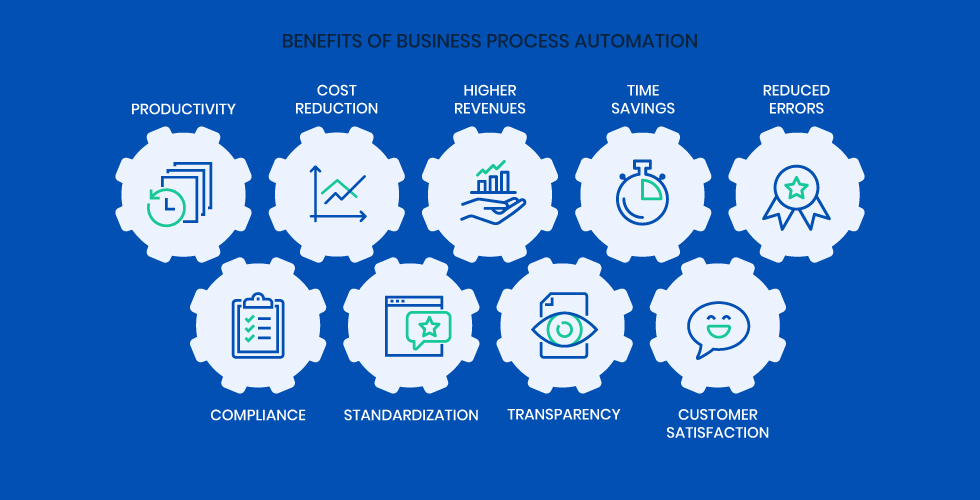We live in a fast-paced business environment in the middle of digital transformation.
This means that businesses need to optimize their workflows and speed up processes to increase efficiency, minimize costs and stay on top of the game.
Digital transformation helps you use tech solutions to create new value and benefits for your business.
If you never came across the term, BPA (Business Process Automation) can simply be defined as leveraging technology to do repetitive tasks, workflows or processes that are mandatory for the company to achieve its goals, and to do it in a pre-programmed, automatic way with minimal human intervention.
In this article, we’ve gathered the most important things to know about BPA and how to approach digital transformation in your daily operations.
Examples of BPA
Today, with all the tools available to assist you in automation, many business processes can be automated. So how do you determine what process to automate? Here are some suggestions for tasks that can be automated:
- Manual tasks
- Recurring tasks
- Tasks in high volume
- Time sensitive tasks
- Tasks that involve multiple people
- Tasks that need compliance
- Or the tasks that require audit

Some company departments use automation more often than others, simply because the nature of their work is more suitable to be programmed automatically. Let’s check out the most common applications of automation within different departments:
HR
HR teams are dedicated to smoothly run employee-related processes to create the best user-experience. Many recurring tasks like filling out forms, creating accounts, setting up bank and tax information, on boarding, documents management and other hiring steps can be automated. This creates benefits for both sides: employees and the HR department staff.
ACCOUNTING
Finance departments make great use of business process automation. From purchase orders to invoice processing and payments, a lot of steps in accounting systems are repetitive. Automating Accounts Payable (AP) process can increase workflow productivity and data accuracy.
MARKETING
BPA in marketing is a wide-spread tool because it is applicable to many marketing processes. Creating content and distributing it across different digital channels to generate potential sales leads is the entire workflow of activities that can be one automated process.
Depending on the software type and features, there are simple tools for managing a single process (for example, email software for sending newsletters) or more complex marketing automation platforms that can connect and integrate various apps and workflows.
SALES
Efficiency in the sales team is the main driver for revenue growth. BPA can help speed up sales processes like on boarding new customers or providing integration with other CRM tools. Automated processes in sales create great user experience and satisfaction.
Other operational processes within the organisation can also qualify for automation, but to determine which ones are the best investment, the company needs to set straight goals, calculate benefits and define in which areas automation can make the most significant impact for the business.
Benefits and Challenges of BPA
Replacing manual work with automated processes can bring your company a chain reaction of inter correlated benefits.
Most obvious one is that BPA saves the time of your employees and gives them a chance to focus on more important tasks or strategies. Also, well defined automation drastically reduces error rates that would normally happen in repetitive manual work.
Automating as much work as possible to speed up processes within your organisation can significantly improve the overall productivity of business operations. Consequently, this will lead to better production, lower costs, and higher revenues.
Another huge benefit of BPA is that it gives a chance to create standardization within a company, and it secures transparency.
Automated processes are more suitable for audit and compliance, and they provide great employee and customer satisfaction.

Digital transformation also comes with certain challenges that can leave the company unprepared. It will take some time to organise new automated workflows and educate staff to use them.
Common problems that can occur during this transition period:
- Limited adoption
- Problems with system integration
- Integrating too many processes without proper planning
- Attempts to automate a bad process that won’t work
How to Automate Business Processes
Key to building a successful BPA for your company is to clearly understand all the processes of your business and approach it with a solid, analysis backed-up plan.
- Analyse your company’s environment This includes deep understanding about operational tasks and workflows that your company uses on a daily basis.
- Choose best candidates for automation Not every process is designed to be automated, some require too much human interference. Option-out which processes in your business are suitable and worth the transition.
- Properly define scope of work If you don’t have any experience with automation, you might want to start small and build your way up. First automate processes that you really understand and those that have a clear and well-defined workflow. More advanced solutions can come after once you establish successful ground for growing integrations.
- Consult key stakeholders Digital transition is a teamwork. You should include your employees and managers to help you define details of each workflow and brainstorm about your plan. People who use those processes can have a pretty good picture on what will work or not.
- Do market research to find best BPA tools Needless to say, every business has its own unique points, and not all solutions fit well with all businesses. After you get a clear idea on what type of automation would best serve your business, devote some time to check out which tool can fulfill your needs.
Business Process Automation FAQ
BPA vs BPM
Business Process Management (BPM) is a practice that analyses complex business processes using different methods.
BPA and BPM have the same goal to improve business processes, but BPM is a larger discipline that includes modelling, analyzing, optimizing, measuring and BPA (automation).
Types of BPA and Differences
- Task Automation Commonly used to replace or minimize manual tasks within a process. Example of tasks that can be automated: sending emails, processing payments, documents capture, help desk communication etc.
- Workflow Automation Manages various tasks and activities to create automatic workflows. It’s used to manage deadlines, work schedules, projects, assigning tasks, monitoring, basically everything that can be automated within a defined workflow.
- Process Automation Includes a combination of tasks and workflows to automate the entire end-to-end process, or the most of it. Some parts of the process may still require manual human intervention, like approvals or decision-making.
- RPA – Robotic Process Automation Simple solution to automate tasks or workflows that don’t require any type of decision-making.
- Intelligent Automation It is the most complex solution that integrates existing RPA’s, task and workflow processes, and combines them with advanced data analysis and artificial intelligence to create higher-value automation processes.
Difference between BPA and RPA
Robotic Process Automation (RPA) is simply a software bot that behaves like a human and executes repetitive tasks in the same way as humans would do. For example, one wider use of RPA is to move data from one place to another in a system. Usually, a human would sit in front of a desktop and start clicking copy-paste to transfer data from one spreadsheet or database to some other location.
A Bot does the same work, just way quicker and with less margin for errors. It’s a simple tool, easy to set up without development skills. Users can create a workflow for the bot, simply by clicking through the dashboard of their preferred automation tool.
Some RPA solutions can be integrated into your existing system as part of Business Process Automation (BPA), but BPA is a much more complex software solution than RPA.
Most common business process to automate
- E-mail messaging and notifications
- Procurement process (Purchase orders)
- Invoicing
- Payrolls
- Sales orders
- Marketing growth leads
- Helpdesk and IT support
To summarize: Business Process Automation can help your business a lot if it’s done properly. If you want to find out how DOKKA can help you with your accounting team’s digital transformation, book a call with our sales team to discuss needs specific to your business.








